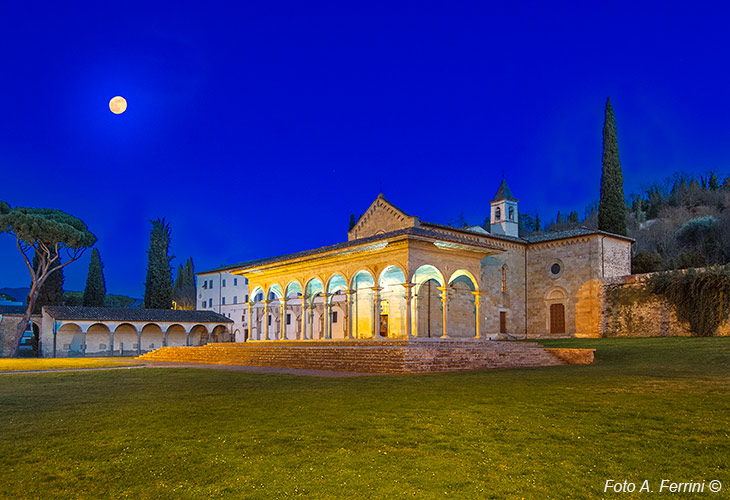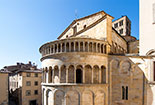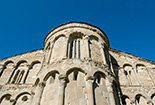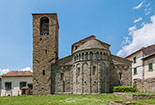SANTA MARIA DELLE GRAZIE
in Arezzo, Tuscan art city that you can know in every detail with this website

Texts and photos by Alessandro Ferrini ©
20 accurately described images of the Sanctuary of Santa Maria delle Grazie. Click to enlarge
Santa Maria delle Grazie, sanctuary in Arezzo
 From Via Benedetto da Maiano, on the southern outskirts of Arezzo, with a detour of one hundred meters we reach Santa Maria delle Grazie, a religious complex located in a small park at the foot of a hill.
From Via Benedetto da Maiano, on the southern outskirts of Arezzo, with a detour of one hundred meters we reach Santa Maria delle Grazie, a religious complex located in a small park at the foot of a hill.
A beautiful arched portal introduces us to the lawn in front of the church. The sacred building and the portico were built in the 15th century, but the curious and interesting history of the place dates back to the Roman period. Here there was a source where pagan rituals of worship were practiced. With Christianization these practices continued, and if in the early Middle Ages this did not disturb the church much, at the end of the 14th century and in the first decades of the 15th the many people who still went to the place to perform rites with the waters of Fonte Tecta (this was her name) believed to be healers began to annoy the clergymen not a little. In 1428 Friar Bernardino, a Sienese Franciscan, with the help of a group of fierce faithful succeeded in destroying the infamous source and in its place he had a chapel built where in 1430 the Arezzo painter Parri di Spinello painted a fresco showing the Madonna della Misericordia, a clear symbol of protection for the people of Arezzo. We can see this work on the altar of the current church.
The place was immediately a place of devotion for the people of Arezzo and beyond. So the chapel was small to accommodate those who came to pray. The construction of the church (the present one) began as early as 1435 and lasted for about ten years. Given the period in the church we can see a mix of late Gothic and Renaissance styles. In 1444 Friar Bernardino died in Aquila, the architect of the destruction of Fonte Tecta, who was already canonized in 1450 by Pope Niccolò V as San Bernardino da Siena. Following this event, a large chapel will be added to the Church of Santa Maria delle Grazie on the right wall dedicated to this important religious figure belonging to the order of Franciscan Friars Minor, in fact the founder of this sacred place in Arezzo.
the order of Franciscan Friars Minor, in fact the founder of this sacred place in Arezzo.
Around 1480 a large and "light" loggia was built against the facade of the church. Forty years have passed since the construction of the latter and we have entered the full Renaissance. In the loggia, designed by Benedetto da Maino, the new style is evident. Slender columns surmounted by Corinthian-style capitals support it. Seven large arches are present on the front, two on the sides.
Santa Maria delle Grazie is also a place of art. We have already spoken of the Madonna della Misericordia by Parri di Spinello. This is inserted in a marble altar made ad hoc at the end of the fifteenth century by Andrea Della Robbia and his sons who normally expressed themselves on ceramics. Above, in the lunette there is a Virgin and Child among angels. In addition to many heads of cherubs, on the sides of the painting there are four statues of San Donato, San Bernardino and the holy martyrs Lorentino and Pergentino. Below is Christ in Pietà between the Virgin and St. John the Evangelist. On the right wall of the church there is a part of a fresco dated 1480 by Lorentino d’Andrea, disciple and imitator of Piero Della Francesca, where Pope Sixtus IV is seen in the act of granting indulgence to the visitors of this church. The Pope is among the Cardinals Gonzaga and Piccolomini, future Pope Pius III. The 1747 wooden choir inside the apse is beautiful and elegant.






























